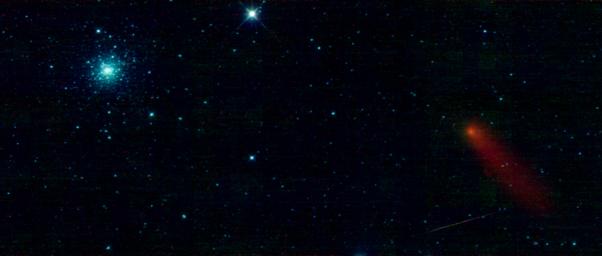
|
M3 & Comet Garradd
- Click the image above for a larger view
- Full-Res JPEG (2349 x 1000) (198.7 kB)
- Full-Res TIFF (2349 x 1000) (7.1 MB)
Caption:
This image from the WISE mission was taken on January 2nd, 2010, during the check-out phase, before the start of the WISE survey. It is a mosaic of 3 individual WISE frames spanning an area on the sky about 7 times the size of the full Moon in portions of the constellations Bootes and Canes Venatici.
In the lower right portion of the image there is a streak of orange light. This is most likely a human-made satellite, orbiting Earth at a higher altitude than the WISE telescope, which is at 523 km above the surface. WISE sees many of these as it scans the sky.
Just above the satellite in the image is Comet C/2008 Q3 (Garradd). Comets are balls of dust and ice left over from the formation of the Solar System. As a comet approaches the Sun it is heated and releases gas and dust from its surface that is blown back by the solar wind into a long, spectacular tail. This comet was discovered in August 2008 by Gordon Garradd of the Siding Spring Observatory in Australia. This comet probably comes from the Oort Cloud, a vast collection of remnants from the formation of the Solar System thought to surround it. At the time the comet was observed by WISE, in the constellation Bootes, it was a distance of 419 million kilometers (2.789 Astronomical Units, AU) from Earth. But we are just catching it while it is near the Sun. The orbit calculated for Comet C/2008 Q3 (Garradd) is inclined to the plane of the Solar System by nearly 140 degrees and takes it very far from the Sun (trillions of kilometers). It made its closest approach to the Sun in June of 2009 at a distance of 1.8 AU (270 million km), just outside the orbit of Mars. If it comes back near the Sun at all, it won't be for hundreds of thousands of years.
In the upper left of the image is the impressive globular cluster Messier 3 (M3). M3 was discovered in the constellation Canes Venatici by famous French Astronomer, Charles Messier in 1764, and first seen to be made of stars around 1784 by the British astronomer who discovered infrared light, William Herschel. Globular clusters are huge globs of stars (hence the name) that are found orbiting in the outer reaches of most galaxies. They are thought to form around the same time that a galaxy forms. The Milky Way has over 200 known globular clusters. M3 is one of the largest and brightest globular clusters around the Milky Way. It is just barely visible to the naked eye from a dark location. M3 is made of about half a million stars, thought to be about 8 billion years old. It is about 150 light-years across (1 light-year is equal to 9.46 trillion km) and located some 34,000 light-years from Earth.
WISE sees invisible infrared light, and the colors here are mapped to 3 of the 4 wavelength bands observed by WISE. Blue represents light with a wavelength of 3.4 microns, cyan maps to 4.6 microns and red is lightat 12 microns (a micron is 1 millionth of a meter, and visible light runs from 0.4-0.7 microns). The light from relatively hot objects, like stars in M3, is seen in blue and cyan. Red color represents cooler things, like dust from the comet and its tail. When this image was taken the WISE team was still calibrating the rate of the scan mirror with the motion of the WISE telescope. The rate was not yet perfected and careful examination of this image reveals some stars that are a little smeared and not exactly aligned in the blue/cyan with the red.
Background Info:
NASA's Jet Propulsion Laboratory, Pasadena, Calif., manages the Wide-field Infrared Survey Explorer for NASA's Science Mission Directorate, Washington. The mission's principal investigator, Edward Wright, is at UCLA. The mission was competitively selected under NASA's Explorers Program managed by the Goddard Space Flight Center, Greenbelt, Md. The science instrument was built by the Space Dynamics Laboratory, Logan, Utah, and the spacecraft was built by Ball Aerospace & Technologies Corp., Boulder, Colo. Science operations and data processing take place at the Infrared Processing and Analysis Center at the California Institute of Technology in Pasadena. Caltech manages JPL for NASA.
More information is online at http://www.nasa.gov/wise and http://wise.astro.ucla.edu .
Cataloging Keywords:
| Name | Value | Additional Values |
|---|---|---|
| Target | C/2008 Q3 (Garradd) | |
| System | ||
| Target Type | Comet | |
| Mission | Near-Earth Object Wide-field Infrared Survey Explorer (NEOWISE) | |
| Instrument Host | NEOWISE | |
| Host Type | Space Telescope | |
| Instrument | NEOWISE Telescope | |
| Detector | ||
| Extra Keywords | Color, Dust, Infrared, Moon | |
| Acquisition Date | ||
| Release Date | 2010-03-26 | |
| Date in Caption | ||
| Image Credit | NASA/JPL-Caltech/UCLA | |
| Source | photojournal.jpl.nasa.gov/catalog/PIA12985 | |
| Identifier | PIA12985 | |
